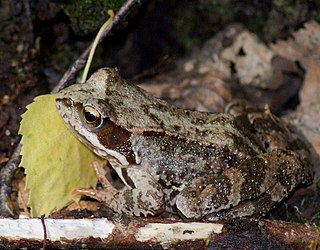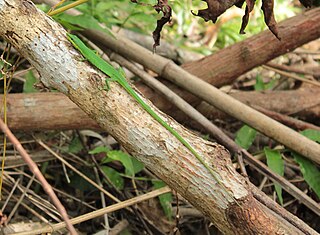
Takydromus is a genus of lizards, commonly called grass lizards or oriental racers. Species of the genus Takydromus are endemic to a large part of Asia. Members of this genus are noticeable because of their slender appearance and their agile movements. The word takydromus derives from Greek ταχυδρόμος (takhudromos), "fast-running", from ταχύς (takhus), "swift" + δρόμος (dromos), "course, race".

The brown anole, also known commonly as the Cuban brown anole, or De la Sagra's anole, is a species of lizard in the family Dactyloidae. The species is native to Cuba and the Bahamas. It has been widely introduced elsewhere, via the importation and exportation of plants where the anole would lay eggs in the soil of the pots, and is now found in Florida and other regions of the United States including southern Georgia, Texas, Louisiana, Tennessee, Mississippi, Alabama, Hawaii, and Southern California. It has also been introduced to other Caribbean islands, Mexico, and Taiwan.

The sand lizard is a lacertid lizard distributed across most of Europe from France and across the continent to Lake Baikal in Russia. It does not occur in European Turkey. Its distribution is often patchy. In the northern extremes of the sand lizard's distribution, such as along the southern English coast of Great Britain, it can only survive by inhabiting seaside heathlands, where the ground temperature is sufficiently elevated from the Sun's rays; the warmth is also critical to the lizard being able to successfully incubate their eggs, which are laid in sand.

The viviparous lizard, or common lizard, is a Eurasian lizard. It lives farther north than any other species of non-marine reptile, and is named for the fact that it is viviparous, meaning it gives birth to live young. Both "Zootoca" and "vivipara" mean "live birth", in (Latinized) Greek and Latin respectively. It was called Lacerta vivipara until the genus Lacerta was split into nine genera in 2007 by Arnold, Arribas & Carranza.

The eastern fence lizard is a medium-sized species of lizard in the family Phrynosomatidae. The species is found along forest edges, rock piles, and rotting logs or stumps in the eastern United States. It is sometimes referred to as the prairie lizard, fence swift, gray lizard, gravid lizard, northern fence lizard or pine lizard. It is also referred to colloquially as the horn-billed lizard. One of its most notable behaviors is that of its escape behavior when encountering fire ants, which have been known to invade and negatively affect many of their populations.

The desert monitor is a species of monitor lizard of the order Squamata found living throughout North Africa and Central and South Asia. The desert monitor is carnivorous, feeding on a wide range of vertebrates and invertebrates.

The moor frog is a slim, reddish-brown, semiaquatic amphibian native to Europe and Asia. Moor frogs are known for their ability to freeze solid and survive thawing. The frog makes use of various cryoprotectants i.e. antifreeze that decrease its internal freezing temperature. The species is distributed over a large range, covering a significant portion of Eurasia. Male moor frogs are known to turn blue temporarily during the height of mating season. This coloration is assumed to signal a mate's fitness. Moor frogs typically mate through multimale amplexus a form of polyandry.

The common house gecko is a gecko native to South and Southeast Asia as well as Near Oceania. It is also known as the Asian house gecko, Pacific house gecko, wall gecko, house lizard, tiktiki, chipkali or moon lizard.

There are several plausible pathways that could lead to an increased extinction risk from climate change. Every plant and animal species has evolved to exist within a certain ecological niche. But climate change leads to changes of temperature and average weather patterns. These changes can push climatic conditions outside of the species' niche, and ultimately render it extinct. Normally, species faced with changing conditions can either adapt in place through microevolution or move to another habitat with suitable conditions. However, the speed of recent climate change is very fast. Due to this rapid change, for example cold-blooded animals may struggle to find a suitable habitat within 50 km of their current location at the end of this century.

The rock firefinch is a species of estrildid finch found in the Jos Plateau of central Nigeria and in Cameroon. It has an estimated global extent of occurrence of 29,000 km2. The rock firefinch was discovered recently, in 1998. Rock firefinches fall in the family Estrildidae, which contains small passerine birds of the Old World and Australasia. Rock firefinches seem to be most closely related to Mali firefinches and Chad firefinches. The species name sanguinodorsalis means blood-red back, which was chosen because it describes the vibrant red back color of the male plumage. The status of the species is evaluated as Least Concern.

Temperature-dependent sex determination (TSD) is a type of environmental sex determination in which the temperatures experienced during embryonic/larval development determine the sex of the offspring. It is observed in reptiles and teleost fish, with some reports of it occurring in species of shrimp. TSD differs from the chromosomal sex-determination systems common among vertebrates. It is the most studied type of environmental sex determination (ESD). Some other conditions, e.g. density, pH, and environmental background color, are also observed to alter sex ratio, which could be classified either as temperature-dependent sex determination or temperature-dependent sex differentiation, depending on the involved mechanisms. As sex-determining mechanisms, TSD and genetic sex determination (GSD) should be considered in an equivalent manner, which can lead to reconsidering the status of fish species that are claimed to have TSD when submitted to extreme temperatures instead of the temperature experienced during development in the wild, since changes in sex ratio with temperature variation are ecologically and evolutionally relevant.

The jacky winter is a small grey-brown robin found commonly throughout Australia and also in Papua New Guinea. The jacky winter acquired its name due to rapid and strong vocalisations, which sound like jacky-jacky winter-winter. Their call is also often referred to as sounding like peter-peter-peter. Its habitats include open woodlands and farmlands.

Xinjiang ground jay or Biddulph's ground jay, is a species of bird in the family Corvidae. It is endemic to China. It is not larger than an adult human's hand and has a brownish white coat of feathers.

The Mongolian ground jay or Henderson's ground jay, is a species of bird in the family Corvidae.

The eastern three-lined skink, also known commonly as the bold-striped cool-skink, is a species of skink, a lizard in the family Scincidae. The species is endemic to Australia. A. duperreyi has been extensively studied in the context of understanding the evolution of learning, viviparity in lizards, and temperature- and genetic-sex determination. A. duperreyi is classified as a species of "Least Concern" by the IUCN.

The golden toad is an extinct species of true toad that was once abundant in a small, high-altitude region of about 4 square kilometres (1.5 sq mi) in an area north of the city of Monteverde, Costa Rica. It was endemic to elfin cloud forest. Also called the Monte Verde toad, Alajuela toad and orange toad, it is commonly considered the "poster child" for the amphibian decline crisis. This toad was first described in 1966 by herpetologist Jay Savage. The last sighting of a single male golden toad was on 15 May 1989, and it has since been classified as extinct by the International Union for Conservation of Nature (IUCN).

The Galápagos penguin is a penguin endemic to the Galápagos Islands and Ecuador. It is the only penguin found north of the equator. Most inhabit Fernandina Island and the west coast of Isabela Island. The cool waters of the Humboldt and Cromwell Currents allow it to survive despite the tropical latitude. The Galápagos penguin is one of the banded penguins, the other species of which live mostly on the coasts of Africa and mainland South America. Due to their warm environment, Galápagos penguins have developed techniques to stay cool. The feathers on their back, flippers, and head are black, and they have a white belly and a stripe looping from their eyes down to their neck and chin. Each penguin keeps only one mate, and breeds year-round. Because there is no soft areas to nest, their nests are typically in caves and crevices which also provide protection against predators and the harsh environment. The Galápagos penguin has a lifespan of 20 years, but due to predation, life expectancy in the wild could be significantly reduced. They have been critically impacted to the point of endangerment by climate change and pollution caused by plastic waste due to tourism and urbanization.

In biology, kleptothermy is any form of thermoregulation by which an animal shares in the metabolic thermogenesis of another animal. It may or may not be reciprocal, and occurs in both endotherms and ectotherms. One of its forms is huddling. However, kleptothermy can happen between different species that share the same habitat, and can also happen in pre-hatching life where embryos are able to detect thermal changes in the environment.

Microlophus albemarlensis, the Galápagos Lava lizard, also known as the Albemarle Lava lizard, is a species of Lava lizard. It is endemic to the Galápagos Islands, where it occurs on several islands in the western archipelago: the large islands Isabela, Santa Cruz, Fernandina, Santiago and Santa Fe, as well as several smaller islands: Seymour, Baltra, Plaza Sur, Daphne Major and Rábida. It is the most widespread of the Galápagos species of Microlophus, the others only occurring on single islands. Some authors however, consider populations on Santiago, Santa Cruz, and Santa Fe to be distinct species. The species is commonly attributed to the genus Microlophus but has been historically placed in the genus Tropidurus.

Takydromus dorsalis, the Sakishima grass lizard, is a species of lizard in the family Lacertidae. It is endemic to the Yaeyama Islands in southern Japan.





















